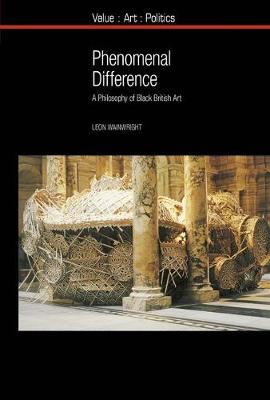Value: Art: Politics
1 primary work
Book 13
Phenomenal Difference grants new attention to contemporary black British art, exploring its critical and social significance through attention to embodied experience, affectivity, the senses and perception.
Numerous extended descriptive studies of artworks spell out the affective and critical relations that pertain between individual works, their viewers and the world at hand: intimate, physically-involving and visceral relations that are brought into being through a wide range of phenomena including performance, photography, installation, photomontage and digital practice.
Whether they subsist through movement, or in time, through gesture, or illusion, black British art is always an arresting nexus of making, feeling and thought. It celebrates particular philosophical interest in:
- the use of art as a place for remembering the personal or collective past;
- the fundamental ‘equivalence’ of texture and colour, and their instances of ‘rupture’;
- figural presence, perceptual reversibility and the agency of objects;
- the grounded materialities of mediation;
- and the interconnections between art, politics and emancipation.
Drawing first hand on the founding, historical texts of early and mid-twentieth century phenomenology (Heidegger; Merleau-Ponty), and current advances in art history, curating and visual anthropology, the author transposes black British art into a freshly expanded and diversified intellectual field. What emerges is a vivid understanding of phenomenal difference: the profoundly material processes of interworking philosophical knowledge and political strategy at the site of black British art.
Featuring attention to works by the following
artists:
Said Adrus, Zarina Bhimji, Sonia Boyce, Vanley
Burke, Chila Burman, Mona Hatoum, Bhajan Hunjan, Permindar Kaur, Sonia Khurana,
Juginder Lamba, Manjeet Lamba, Hew Locke, Yeu-Lai Mo, Henna Nadeem, Kori
Newkirk, Johannes Phokela, Keith Piper, Shanti Thomas, Aubrey Williams, Mario
Ybarra Jr.
Numerous extended descriptive studies of artworks spell out the affective and critical relations that pertain between individual works, their viewers and the world at hand: intimate, physically-involving and visceral relations that are brought into being through a wide range of phenomena including performance, photography, installation, photomontage and digital practice.
Whether they subsist through movement, or in time, through gesture, or illusion, black British art is always an arresting nexus of making, feeling and thought. It celebrates particular philosophical interest in:
- the use of art as a place for remembering the personal or collective past;
- the fundamental ‘equivalence’ of texture and colour, and their instances of ‘rupture’;
- figural presence, perceptual reversibility and the agency of objects;
- the grounded materialities of mediation;
- and the interconnections between art, politics and emancipation.
Drawing first hand on the founding, historical texts of early and mid-twentieth century phenomenology (Heidegger; Merleau-Ponty), and current advances in art history, curating and visual anthropology, the author transposes black British art into a freshly expanded and diversified intellectual field. What emerges is a vivid understanding of phenomenal difference: the profoundly material processes of interworking philosophical knowledge and political strategy at the site of black British art.
